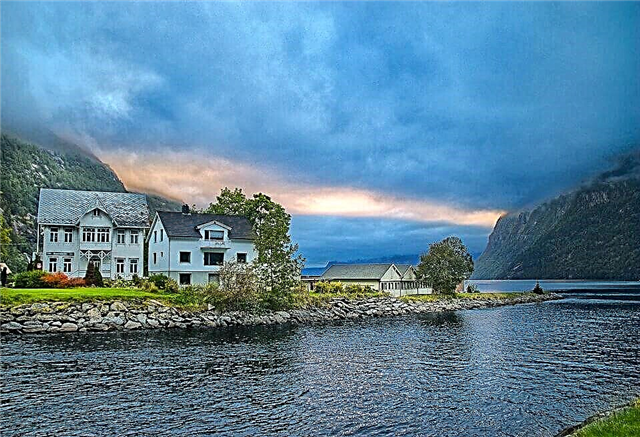In the old Kremlin, on the banks of the Volga, you can see an amazing building made of large bricks - the palace of appanage princes who ruled the city in the Middle Ages. The beautiful chambers were built during the reign of Prince Andrew the Bolshoi, the fourth son of the Moscow prince Vasily II the Dark. One building has survived from the large palace complex, and it is considered a rare monument of civil architecture.
History of chambers
Luxurious mansions in Uglich appeared in the 1480s. The long palace was located along the Volga River, parallel to the northern wall of the Kremlin. The princely chambers consisted of a suite of rooms where the main events in the life of the city took place. It was possible to enter here directly from the main square of Uglich.

The princely residence had rich decorations inside and out. The palace had expensive mica windows, the walls were decorated with paintings, graceful ceramic balusters and multicolored tiles. Covered passages connected the palace chamber with other princely buildings and the city cathedral.
According to the recollections of contemporaries, none of the rulers of the appanage principalities of Ancient Rus had such a representative palace as that of Andrey the Bolshoi. In 1900, large-scale excavations were carried out in Uglich. Archaeologists did a great job and learned that in terms of size and decoration, the chambers of the appanage princes of Uglich differed little from the building of the Grand Ducal Palace in Moscow.

The fate of the brother of the Moscow prince Ivan Vasilyevich was not easy. Andrei was born when his parents were imprisoned in Uglich. After the death of his father in 1481, the young prince took possession of the Volga city. In addition to the prince's palace, during the reign of Andrei Vasilyevich, the majestic Transfiguration Cathedral and the main temple of the male Paisiev monastery, which is located on the other bank of the Volga, were built.
The mind, prudence and wealth of Andrew the Bolshoi became one of the reasons for discord at the royal court. As a result of intrigues, the Uglich prince fell into disgrace. In 1492 he was summoned to Moscow, deprived of power and imprisoned in prison.

The harsh conditions of the prison did not have the best effect on the health of the ruler of Uglich. In 1493, at the age of 47, the prince died. Andrei Bolshoi's two daughters were not touched, and his sons, Ivan and Dmitry, were also imprisoned in prison, and they were forced to spend most of their lives in chains.
In the 16th century, princes and governors appointed by Moscow lived in the Uglich palace. After the death of Tsar Ivan IV the Terrible, in 1584 his son Dmitry came here. The boy was accompanied by his mother Maria Fedorovna Nagaya, numerous relatives and a representative retinue.

Monument to Tsarevich Dmitry
Tragedy struck in 1591. Near the princely chambers, the body of an eight-year-old prince was found. Whether he died a violent death or died through negligence, it was not clear. An investigation began immediately. Without waiting for the trial, an angry crowd of residents of Uglich executed the uncles of little Dmitry, throwing stones at them.
Later, it turned out that the Nagy were not to blame for the death of the young prince, but the repression could no longer be stopped. The mother of Tsarevich Maria Nagaya was forcibly tonsured into a nun, and the rest of the Uglich people - about 200 people - were either executed or exiled to Siberia for eternal exile. The Time of Troubles began in Russia, which led to the fall of the Rurik dynasty and a prolonged civil war.

At the very beginning of the 17th century, the princely chambers were occupied by the physician and pharmacist Gustav of Sweden, the son of the Swedish king Eric XIV. The illiterate residents of the city called the foreigner they did not understand "a warlock" and did not trust the prince, although the highly educated Gustav did not deserve such an assessment.
Later, during the Polish-Lithuanian intervention, desperate townspeople fled to the palace, hoping that the stone walls would save them from their enemies, but this did not help. From the documents it is known that during the invasion of the Polish troops, a lot of blood was shed in the palace, and the basements of the building were full of corpses. Leaving Uglich, the enemies completely burned down the palace.

The city in which little Dmitry died was not favored by Peter I. Under him, most of the destroyed palace buildings were dismantled into bricks. The building material was used for the foundation of a new stone cathedral and the construction of annexes in the Kremlin, so little remained of the former princely residence. The inhabitants of the city asked the tsar to allocate funds for the repair of the surviving princely chambers, but their request was never heard.
In 1753, the architect Dmitry Vasilyevich Ukhtomsky examined the throne chamber and came to the conclusion that it was so dilapidated that it could not be restored. The architect noted that the walls of the medieval building were cracked and the roof collapsed. Ukhtomsky suggested not to waste energy on restoration, but to demolish the remains of the old palace and build something new on the vacant place.

The situation changed in 1802. Wealthy merchant A.V. Kozhevnikov allocated money for a complete reconstruction of the chambers. The building now has a solid iron roof, a new porch, a wrought-iron fence on columns, and the symbol of the Russian state, a large two-headed eagle, was erected on the roof. At the same time, the old paintings in the throne room or the princely hallway were replaced with new ones.
In the 1890s, Uglich was preparing to celebrate the 300th anniversary of the death of Tsarevich Dmitry. Within two years - from 1890 to 1892, the old chambers were carefully restored under the guidance of an experienced architect and a recognized connoisseur of the "Russian" style Nikolai Vadimovich Sultanov. The famous architect and art critic approached the matter with all diligence. He changed the shape of the roof, covered it with copper sheets and made a cross vault in the ceremonial hall.

The main innovation of Sultanov was a new magnificent porch in the tradition of the 17th century with beautiful hipped roofs. The builders carefully scraped off the ancient plaster and exposed the brick walls of the palace. After a large-scale restoration in the princely chambers, the first historical museum in the city began to work.
Architectural features and interiors
The old chambers were rebuilt many times and acquired a modern look after the reconstruction, which was carried out at the end of the 19th century. The building is square in plan and is made of solid brick and has three tiers. The lower part is occupied by a high stone basement, which has grown deeply into the ground over several centuries.

View of the fresco of the image of the Savior Not Made by Hands
The tower-like building has an eight-pitched roof. The bottom of the facades looks rather austere, but at the top you can see beautiful brick patterns that imitate white stone decor.
On the middle floor there are three living rooms for the princes, and on the upper tier there is a large vaulted hall with narrow windows. From pre-Petrine times, only one fresco remained in the palace - the image of the Savior Not Made by Hands on the southern wall. All other artifacts that are exhibited in the chambers belong to the 17th-19th centuries.

Useful information for tourists
The part of the residence of the appanage princes of Uglich that has survived to this day is of great historical and cultural value, because few civil buildings more than 500 years old have survived on the territory of our country. For this reason, Uglich chambers are very popular with tourists who travel to the cities of the “Golden Ring” of Russia.
On the first two floors of the building there are museum expositions dedicated to the history of the ancient Russian city. Ancient weapons are exhibited in the chambers - shields, axes and spears, stove tiles, liturgical utensils, arts and crafts, and fine wood carvings.

The doors of the museum are open to tourists from 9:00 to 18:00. Entrance costs 80 rubles (2021) for an adult. Children under 7 years old are admitted free of charge. The exposition is small, so 30 minutes are enough to view it.
How to get there
The territory of the Uglich Kremlin is located in the historical center of the city, 3 km from the railway station. If you came to Uglich by train, you can walk to the ancient chambers, take a bus or taxi. It is easier for tourists who get to Uglich by intercity buses. From the city bus station to the Kremlin, only 5 minutes walk.
Information sources
- Wikipedia, Chambers of Uglich princes
- Uglich State Historical, Architectural and Art Museum
- Chamber of the palace of the Uglich appanage princes
- Kultura.rf, Uglich Kremlin Ensemble
Attraction rating:











